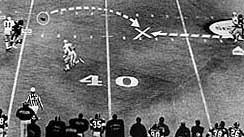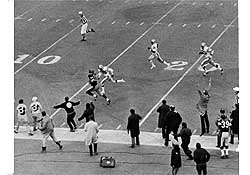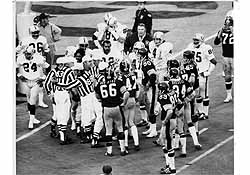Divine intervention with 'Immaculate Reception'
Pittsburgh had all but lost in the '72 playoffs, but then …
From 1933 through 1971, the Pittsburgh Steelers (actually the Pirates for their first seven seasons) were as downtrodden a franchise as you could imagine. In those 39 seasons they appeared in exactly one postseason game-a 21-0 loss to the hated cross-state Eagles in 1947.
It took a miracle to spin the Steelers into an upward trajectory. It took the "Immaculate Reception," the impossible ending to a 1972 AFC Divisional Playoff Game that NFL.com fans have honored as number two on the list of the NFL's Most Memorable Games.
| Below is a sequence of photos depicting Franco Harris' "Immaculate Reception": |
 |
 |
 |
 |
"What surprises me is that young people, who weren't even born then, want to talk about it," says John (Frenchy) Fuqua, the pivot man in this surreal event. "They describe it to me, and it's like they were there and I wasn't."
Fuqua was indeed there, surrounded by up-and-coming stars. Terry Bradshaw was in his third season with the Steelers, though he had yet to find his comfort zone as an NFL quarterback. Franco Harris was an exciting rookie out of Penn State. (Mean) Joe Greene, Jack Ham, and Mel Blount all were part of Pittsburgh's defense. On the other side of the field, the Oakland Raiders were stocked with future Pro Bowl Football Hall of Fame enshrinees: wide receiver Fred Biletnikoff, cornerback Willie Brown, center Jim Otto, guard Gene Upshaw, and tackle Art Shell.
Unfortunately for the Raiders, their once-sensational quarterback, Daryle Lamonica, was flu-ridden and ineffective on this cold December day in Pittsburgh. So the Raiders trotted out a replacement-the young Ken Stabler, who wouldn't relinquish the job for most of the decade.
Those who remember Stabler as a brittle-kneed, if deadly accurate, quarterback may be surprised when reminded of the second biggest play of the game. It was a 30-yard run by the sprightly quarterback, a swiftly plunged dagger that gave the Raiders a 7-6 lead with just 1:13 remaining.
By the time 22 seconds showed on the clock, the Steelers had advanced only to their 40-yard line. The dreams that club owner Art Rooney and the working-class loyalists of Pittsburgh had carried around for 40 years were withering before their eyes.
In the huddle, Bradshaw called "66 Option." He dropped back to pass and immediately felt heat from Oakland's Horace Jones and Tony Cline. Raiders safety Jack Tatum set his cross hairs on Fuqua, who had run a hook about 15 yards downfield, as Bradshaw drifted to his right.
"He should've been able to hit Preston Pearson, who was wide open [on a post route]," Fuqua remembers. "But I looked directly in those blue eyes, and I knew he was going to throw to me. I could see Tatum was heading toward the middle of the field, and that the location of the pass would bring me on a collision course with him. I'm thinking that I just want to get my body between him and the ball. Now Bradshaw has released the ball, and here's Tatum. I hear his footsteps, then I hear his breath, then his heartbeat."
Tatum and the pass met Fuqua at approximately the same time, and the force of the hit sent the ball ricocheting across the field. Tatum and some of the other Raiders began to celebrate. Bradshaw threw his helmet to the ground in despair. Art Rooney never saw any of it; he was riding the elevator down to locker-room level, preparing to give his team a consolation pep talk. He had to rewrite the speech.
Harris, who had drifted out of the backfield, rescued the ball just before it hit the ground and, never breaking stride, dashed 60 yards for the most creative touchdown this side of Adelphia Coliseum.
The Raiders were livid. The rules of the time stated that two offensive players could not touch a pass in succession, and they were sure Fuqua had batted it to Harris. John Madden, the thunderous Oakland coach, chased an official, yelling, "no good, no good."
As it turned out, the officiating crew had no idea exactly what had transpired. Referee Fred Swearingen ducked into a stadium dugout and phoned upstairs to Art McNally, the NFL supervisor of officials. As far as anybody could tell, Tatum and Fuqua had touched the ball simultaneously. Swearingen ran back onto the field and signaled the touchdown.
Delirious fans poured onto the field, but were quickly shooed away. Five seconds remained on the clock. Moments later they, too, were gone.
The Pittsburgh Steelers were winners, finally. A week later they would become the sixteenth victim in the Dolphins' perfect 17-0 season, but they had taken the first step toward four Super Bowl trophies. Pittsburgh and Oakland would meet in each of the next four postseason tournaments, forging a sometimes vicious rivalry.
So what really occurred at Three Rivers Stadium? Instant replay wouldn't have helped the officials much in this case. The replay has been rewound a hundred times, and most viewers still aren't sure. Fuqua claims he's the only one who truly knows, and he's willing to divulge the secret-for the low, low price of $100,000.
"On the twenty-fifth anniversary of the game, they flew me in," says the mischievous Fuqua, who now works in circulation for Detroit Newspapers. "We were filming, and I went into the bathroom. I'm splashing my face, and here comes Bradshaw. He says, 'Frenchy, tell me what happened.'
I said, 'Well, I want to keep it Immaculate, but I guess I can tell a teammate.'
"That's when I noticed the little microphone on his lapel. He was bugged. Can you believe it? A teammate!"
One would think Fuqua-and anybody else who witnessed the events of December 23, 1972-could believe just about anything.